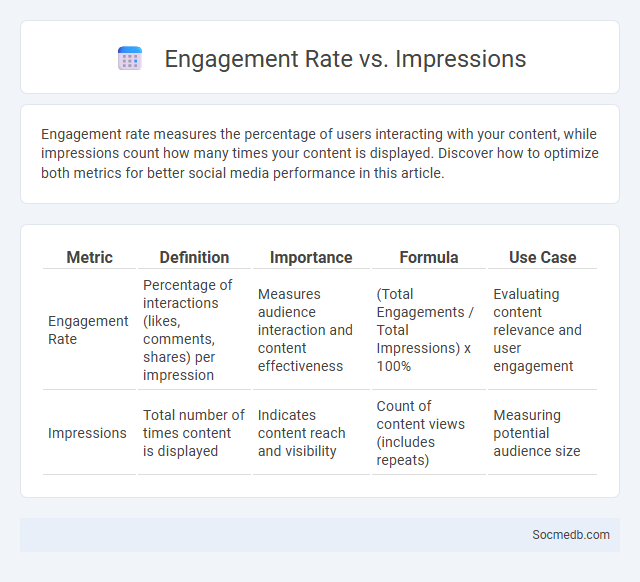
Photo illustration: Engagement Rate vs Impressions
Engagement rate measures the percentage of users interacting with your content, while impressions count how many times your content is displayed. Discover how to optimize both metrics for better social media performance in this article.
Table of Comparison
| Metric | Definition | Importance | Formula | Use Case |
|---|---|---|---|---|
| Engagement Rate | Percentage of interactions (likes, comments, shares) per impression | Measures audience interaction and content effectiveness | (Total Engagements / Total Impressions) x 100% | Evaluating content relevance and user engagement |
| Impressions | Total number of times content is displayed | Indicates content reach and visibility | Count of content views (includes repeats) | Measuring potential audience size |
Understanding Engagement Rate: Definition and Importance
Engagement rate measures the level of interaction your social media content receives, calculated by dividing total engagements (likes, comments, shares) by your total followers and multiplying by 100. This metric provides critical insights into how well your audience connects with your posts, reflecting content relevance and effectiveness. Understanding engagement rate helps you refine strategies to boost visibility, audience retention, and overall social media performance.
What Are Impressions? Key Insights for Marketers
Impressions on social media refer to the total number of times a post or advertisement is displayed to users, regardless of interaction. Marketers rely on impressions to gauge content visibility, brand exposure, and potential reach within target audiences. High impression counts indicate strong awareness efforts but should be analyzed alongside engagement metrics for a comprehensive effectiveness assessment.
Engagement Rate vs. Impressions: Core Differences
Engagement rate measures the percentage of user interactions, such as likes, comments, and shares, relative to the total impressions, indicating the effectiveness of content in capturing audience interest. Impressions represent the total number of times content is displayed, regardless of user interaction, providing insight into reach but not engagement quality. Understanding the core differences between engagement rate and impressions allows marketers to optimize social media strategies by balancing visibility with meaningful audience interaction.
Calculating Engagement Rate: Essential Formulas
Calculating engagement rate involves measuring the interaction level between content and audience, typically using formulas like (Total Engagements / Total Followers) x 100 to yield a percentage reflecting audience involvement. Another key formula is (Total Engagements / Total Impressions) x 100, which accounts for the engagement relative to content exposure, crucial for assessing campaign effectiveness. Utilizing these formulas helps marketers optimize content strategy by understanding how likes, comments, shares, and clicks contribute to overall social media performance.
Why Impressions Matter in Social Media Analytics
Impressions in social media analytics quantify how often content is displayed, providing critical insights into audience reach and brand visibility. Tracking impressions helps businesses measure the effectiveness of campaigns by revealing exposure frequency, which directly influences engagement potential and awareness growth. High impression counts indicate successful content distribution, enabling marketers to optimize strategies and allocate resources more efficiently.
The Impact of Engagement Rate on Campaign Success
Engagement rate directly influences social media campaign success by measuring audience interaction through likes, comments, shares, and clicks. Higher engagement rates indicate strong content resonance, improving organic reach and boosting brand visibility. Analyzing engagement metrics enables marketers to optimize content strategies, ensuring enhanced ROI and campaign effectiveness.
Common Mistakes When Interpreting Engagement Metrics
Misinterpreting social media engagement metrics often involves confusing vanity metrics like likes and followers with meaningful indicators of audience interaction and conversion potential. Overlooking the context behind metrics, such as the timing of posts or the type of content, can lead to flawed conclusions about campaign effectiveness. Accurate analysis requires focusing on engagement quality, such as comments and shares that indicate genuine user interest and brand sentiment.
How to Improve Engagement Rate Effectively
To improve your social media engagement rate effectively, focus on creating high-quality, relevant content tailored to your target audience's interests and behaviors. Utilize interactive elements such as polls, questions, and live videos to encourage active participation and foster community connection. Consistently analyze engagement metrics to refine posting schedules and content strategies for optimal reach and interaction.
Balancing Engagement Rate and Impressions for Optimal Results
Balancing your social media engagement rate and impressions is crucial for maximizing reach and interaction. Higher engagement rates indicate meaningful connections with your audience, while a broad impression count ensures your content is widely visible. Strategically optimizing both metrics helps you achieve the most effective and impactful social media presence.
Measuring Social Media Performance: Best Practices and Tools
Measuring social media performance involves analyzing key metrics such as engagement rate, reach, impressions, and conversion rates to evaluate the effectiveness of campaigns. Best practices include setting clear objectives, using consistent tracking methods, and leveraging tools like Google Analytics, Hootsuite, and Sprout Social for comprehensive data insights. Regularly monitoring performance metrics enables businesses to optimize strategies, improve audience targeting, and maximize return on investment (ROI).
 socmedb.com
socmedb.com